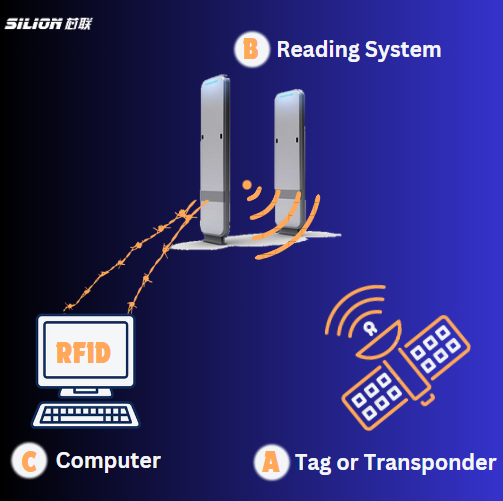Your location: Home Page > RFID Blog | SILION TECH > Understanding the Core Elements of an RFID System
News and Information
Understanding the Core Elements of an RFID System
Author:2024-07-11 14:41:49
RFID systems enhance efficiency, improve tracking, and streamline operations. But what exactly makes up an RFID system? Let's dive into the core elements and understand how they work together to achieve seamless data exchange and management.

1. The Reader: Transmitting the Signal
The first component of an RFID system is the reader, also known as an interrogator. The reader's primary function is to transmit a low-power radio signal through its antenna. This signal is essential as it is received by the RFID tag via its own antenna, powering the integrated circuit (chip) within the tag.
The reader's antenna is designed to emit radio waves over a specific frequency, depending on the RFID technology being used. These frequencies can vary, typically falling into low-frequency (LF), high-frequency (HF), and ultra-high-frequency (UHF) bands. The choice of frequency impacts the range, speed, and interference characteristics of the system.
When the reader transmits this signal, it creates an electromagnetic field in its vicinity. Any RFID tag entering this field will capture the radio signal through its antenna. The power generated by this captured signal is sufficient to activate the tag's integrated circuit, initiating the next phase of the process.
2. The Tag: Capturing and Conversing
The RFID tag is a small device comprising an antenna and an integrated circuit (chip). When the tag enters the radio field generated by the reader, it captures the radio signal through its antenna. This captured signal powers the integrated circuit, allowing the tag to function without an internal power source (in the case of passive RFID tags).
Upon activation, the tag uses the energy harvested from the reader's signal to briefly converse with the reader. This conversation involves the tag transmitting its unique identification data back to the reader. The tag may also receive commands from the reader, allowing it to send additional data or perform specific functions.
This data exchange process is rapid and efficient. The tag's integrated circuit controls the communication, ensuring that the correct data is sent back to the reader. In some cases, the tag may also have memory storage to hold additional information, such as product details or tracking history. This interaction between the tag and the reader is a critical step, enabling the identification and tracking of tagged items within the reader's range.
3. The Reader to Computer: Processing and Management
Once the data is received by the reader from the tag, it is then sent to a controlling computer for processing and management. This step involves transmitting the collected data over a wired or wireless network to a centralized system where it can be analyzed and used for various applications.
The controlling computer is typically equipped with specialized software designed to interpret the RFID data. This software can perform a range of functions, from simple inventory updates to complex data analytics. The data is processed to extract valuable information, such as the location, status, or movement of tagged items.
The management software can integrate with other systems, such as enterprise resource planning (ERP) or warehouse management systems (WMS), providing a seamless flow of information across the organization. This integration enables real-time visibility and control over assets, inventory, and processes, enhancing operational efficiency and decision-making.
Practical Applications and Benefits
Understanding the core elements of an RFID system helps to appreciate its practical applications and benefits. RFID systems are widely used in various industries due to their ability to automate identification and tracking processes.
In retail, RFID systems enable efficient inventory management, reducing out-of-stock situations and improving customer satisfaction. Tags on products allow retailers to track stock levels in real-time, optimize replenishment, and prevent theft.
In logistics and supply chain management, RFID technology enhances the visibility and traceability of goods as they move through the supply chain. This visibility helps in reducing errors, improving delivery times, and ensuring product authenticity.
Healthcare facilities use RFID systems to track medical equipment, manage patient information, and enhance security. The ability to quickly locate critical equipment and ensure accurate patient records contributes to improved patient care and operational efficiency.
Security applications benefit from RFID technology through access control systems that use RFID tags to grant or restrict entry to secure areas. This ensures that only authorized personnel can access sensitive locations.
The fundamental elements of an RFID system—the reader, the tag, and the controlling computer—work together to create a powerful tool for identification and tracking. The reader transmits a signal to power the tag, the tag converses with the reader to exchange data, and the reader sends this data to a computer for processing and management. This seamless interaction enables a wide range of applications across various industries, driving efficiency, accuracy, and security.
By understanding these core components, businesses can better leverage RFID technology to optimize their operations and gain a competitive edge. Whether it's improving inventory management, enhancing supply chain visibility, or increasing security, RFID systems offer a versatile and effective solution for modern challenges.
Next Article:Power Petrol Inspection Management System through RFID